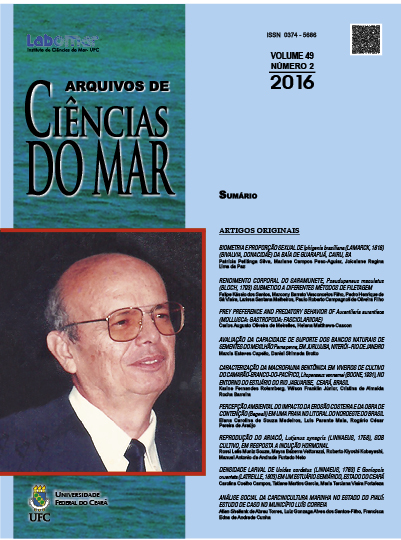CHARACTERIZATION OF ARTISANAL FISHING IN FISHWEIRS, THE NORTH COAST OF PARAIBA, BRAZIL
DOI:
https://doi.org/10.32360/acmar.v49i2.6585Keywords:
Ethnoichthyology. Fishing Production. Ichthyofauna. Traditional Population.Abstract
Traditional fishing strategies are used by fishing communities around the world, such as fish-weirs, which are fixed traps built along a coastal zone. This study aims to characterize and describe how fish-weirs are managed by fishermen from the coastal state of Paraíba in the Northeast Brazil. Unplanned interviews, “rapport”,“Snow ball”, and direct observation were carried out during monthly visits to five fish-weirs, from November 2012 to March 2013. We quantified fish-weirs production, and identified the most species caught. These traps are made up of compartments and go through steps both, on land and at sea, until they are completely activated. The total fish production was 303 kg. The predominant species were: Mugil curema and Mugil liza, Trichiurus lepturus,Caranx hippos,Selene vomer and Selene setapinnis, and Diapterus auratus and Diapterus rhombeus. We concluded that this type of fishing has been used for decades on the coast of Paraíba, and that the fishermen have their own management and techniques, used with this type of trap.Downloads
Published
2017-05-05
Issue
Section
Artigos originais
License
1. Proposta de Política para Periódicos de Acesso Livre
Autores que publicam nesta revista concordam com os seguintes termos:
- Autores mantém os direitos autorais e concedem à revista o direito de primeira publicação, com o trabalho simultaneamente licenciado sob a Licença Creative Commons Attribution que permite o compartilhamento do trabalho com reconhecimento da autoria e publicação inicial nesta revista.
- Autores têm autorização para assumir contratos adicionais separadamente, para distribuição não-exclusiva da versão do trabalho publicada nesta revista (ex.: publicar em repositório institucional ou como capítulo de livro), com reconhecimento de autoria e publicação inicial nesta revista.
- Autores têm permissão e são estimulados a publicar e distribuir seu trabalho online (ex.: em repositórios institucionais ou na sua página pessoal) a qualquer ponto antes ou durante o processo editorial, já que isso pode gerar alterações produtivas, bem como aumentar o impacto e a citação do trabalho publicado (Veja O Efeito do Acesso Livre).

